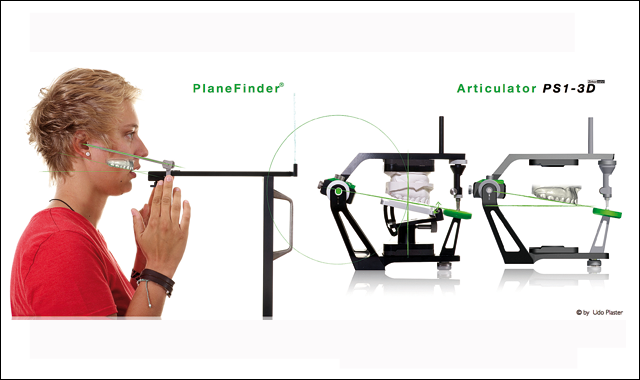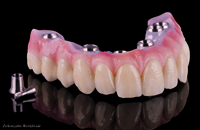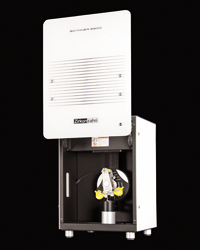Featured brands: Zirkonzahn: Steps to an ideal digital workflow

Accurate patient evaluation-for added safety when planning dental restorations
The PlaneSystem® helps ascertain the occlusal plane, complete with its asymmetries, without the usual facebow transfer.

Visualized at its natural inclination, the occlusal plane is easy to reproduce on the Zirkonzahn PS1 virtual articulator with the appropriate geometries. The patient’s important intraoral data (the midline and the occlusion plane with its three-dimensional shape) is processed and faithfully reproduced.
10 Questions: Zirkonzahn's Enrico Steger on artistry through CAD/CAM
This allows possible compensations to be detected prior to developing a treatment plan for laboratory or chairside restorations, minimizing or completely eliminating any sources of error, particularly during data transfer, that might otherwise occur when planning or fabricating a dental restoration.
Face Hunter-3D facial scanner for photorealistic visualization
Ideally, the physiognomy of the patient is taken into account when designing a dental restoration. This step can be taken with the Face Hunter 3D facial scanner. A single click will digitize a face within three-tenths of a second. The 3D digital image is a photorealistic representation of the final restoration, making the planning process more reliable for the dental technician, dentist and patient.
Hot read: 5 Benefits of using cloud-based management software for dental labs
Continue reading on Page 2 ...
The Face Hunter’s features include:
- Planning reliability for the dental technician, dentist and patient through the manufacture of tooth restorations based on the patient’s physiognomy.
- Intuitive controls: digitization with a single click.
- High scanning speed: less than three-tenths of a second per face.
- Extremely good integration into the Zirkonzahn workflow. The facial-scan data is incorporated into the data obtained by the Zirkonzahn.Modellier mock-up software in combination with the S600 ARTI scanner via a patented process.
- Ideal for presenting restoration and patient consultations when combined with the CAD/CAM Reality Mode software module (photorealistic visualization in realistic colors).
Scanner S600 ARTI-a high-precision, structured-light optical scanner

For an uninterrupted digital workflow, the data received and the corresponding coordinates in three-dimensional space must be correctly matched. The fully automated S600 ARTI structured-light optical scanner and the virtual articulator implemented in the Zirkonzahn modeling software join forces to perform this task easily and masterfully.
The scanner acquires data from the PS1 articulator, both of the models and of the articulator itself and transfers the data directly to the software’s virtual articulator. More than 20 software modules are available specifically for this purpose.
Interesting read: 21 CAD tips that will take your work to the next level
Continue reading on Page 3 ...
Prettau® Zirconia and Prettau® Anterior®-when other materials are too weak
Zirkonzahn CEO Enrico Steger and his team of researchers incessantly work on new innovations. Steger himself has already invented and launched various products on the market, from the manual copy milling system “Zirkograph” to an extensive range of CAD/CAM machines and accessories. Quite in line with the company name, Zirkonzahn has always remained loyal to the material zirconium oxide, the connecting element.
More from Zirkonzahn: A new, super translucent zirconia for ideal esthetics and strength

Zirkonzahn’s first development in terms of zirconia was Prettau® Zirconia. Prettau® Zirconia is a highly translucent, exceptionally biocompatible and nonporous material. Thanks to its high translucency, natural appearance and a special coloring technique, it is possible to entirely eliminate the use of veneer ceramics in all functional areas of the denture. For this, the zirconia should be stained with infiltration colors before sintering. The glazing occurs afterwards.
With Prettau® Zirconia and the Prettau® Bridge firmly established among experts, Zirkonzahn has now succeeded in making another technical progress: Prettau® Anterior®. Prettau® Anterior® is a new and extremely biocompatible zirconia material that is especially suited for use in the anterior tooth area due to its high translucency. Thanks to its high bending strength, it offers an ideal alternative to lithium disilicate. In a test procedure carried out by the University of Pennsylvania and aimed at determining the bending strength, Prettau® Anterior® reached a value of 670 MPa. In the biaxial tensile test carried out in accordance with ISO 6872, lithium disilicate only showed values of approx. 360 MPa (+/- 60 MPa).
Hot read: 5 CAD features to consider-BEFORE you buy
Continue reading on Page 4 ...

Due to the optimized microstructure of the zirconium oxide, Prettau® Anterior® is not only highly translucent but also particularly esthetic. In combination with the Colour Liquids Prettau® Anterior® Aquarell, especially developed for this purpose, as well as the ICE Zirkon Malfarben Prettau® Stains and the ICE Zirkon Malfarben 3D by Enrico Steger Stains, it is now possible to work fully anatomically also in the anterior area. In this way, the problem of ceramic chipping also can be avoided. As with Prettau® Zirconia, the know-how of the dental technician is not particularly required for the layering technique but rather for the coloring technique. The occlusal surface no longer needs to be tediously layered with ceramics as it is being directly copied from the modeled tooth.
M1 Milling Unit Compact Line
The development of the compact line was based on the proven M5 milling-unit technology of Zirkonzahn’s flagship range and is available in several models designed to match the needs and budget of any dental laboratory looking to take advantage of computer-aided manufacture. The four-axis Milling Unit M1 Abutment model can, for example, process precast titanium abutments Raw-Abutments®, as well as glass ceramics (the Raw-Abutments® can also be processed with the M5 and M1 Wet Heavy Metal Milling Units with the aid of the Raw-Abutment® Holder).
Related reading: Zirkonzahn line of M1 milling units offer multiple options for milling
Continue reading on Page 5 ...
Alternatively, the M1 Soft, M1 Wet and M1 Wet Heavy Metal models are provided with intelligent five-axis orbit technology to deliver the ultimate in versatility. This means milling is possible in any conceivable plane-even undercuts and diverging abutments are processed simply and quickly. Thus, besides crowns, bridges, inlays, onlays and telescopic crowns, full zirconia abutments, screw connections, attachments, bars and full prosthesis can be created. Each model is designed to work with different materials.
The M1 Soft will mill all soft materials, such as Prettau® Zirconia, Zirkonzahn’s signature translucent zirconia material, as well as PMMA, wood, wax or even sinter metal. The M1 Wet also incorporates a wet-processing function that allows grinding of not only soft materials but also the increasingly popular glass ceramics. The top-of-the-range M1 Wet Heavy Metal Milling Unit offers complete versatility with both wet and dry processing functions for all soft materials and glass ceramics, as well as hard materials, including titanium and chrome cobalt. The Compact line Milling Unit M1 is particularly compact and space saving (48 x 69 x 61 cm / 19 x 27 x 24 in.) and is characterized by its extremely short milling time thanks to the high speed milling engine.
More great reading: How to take your lab from traditional to all-digital
ACTIVA BioACTIVE Bulk Flow Marks Pulpdent’s First Major Product Release in 4 Years
December 12th 2024Next-generation bulk-fill dental restorative raises the standard of care for bulk-fill procedures by providing natural remineralization support, while also overcoming current bulk-fill limitations.